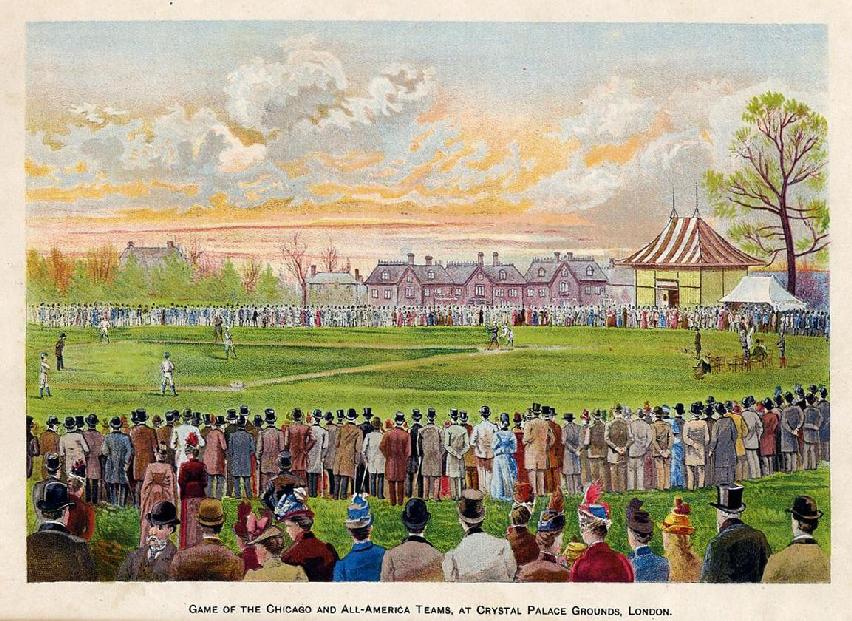
Thomas Macaulay, Ernest Thayer, and Two Peoples Divided by a Common Ballad
Among the many signs of the growing popularity of baseball in the UK, Major League Baseball has announced the renewal of the "London Series" of games which began in 2019 when the Red Sox and Yankees played the first two regular-season MLB games ever played in Britain, at the London Stadium. On June 24 and 25, 2023, the Cardinals and Cubs revived the series after a three-year pandemic-related hiatus. And today (June 9, 2024) the Phillies are leading the Mets in the second game of a weekend series in London Stadium. But in reality, the first professional baseball games (exhibition games) were played in London over 130 years ago. In the spring of 1889, baseball's indefatigable promoter, entrepreneur, and chronicler--Albert Goodwill Spalding--brought his All-Star and Chicago White Stockings teams to London on the last leg of their 'round-the-world tour. They played on the grounds of the Crystal Palace, located in a southeast suburb of London on Sydenham Hill--about twelve miles from where the Cardinals and Cubs will play at the London Stadium--originally constructed for the 2012 London Olympics.

London Stadium, where the first #LondonSeries was played June 29-30, 2019
"'It was desirable,' [ said Spalding at a dinner in London], 'that there should be some sport in which the people of England and America could come together upon an equal footing, and at the same time take a lively interest in it.' He hoped some English friends would take up baseball and introduce it as an English sport, and if they came to America he would guarantee them a cordial reception and magnificent crowds."[1]
Spalding graciously allowed in his remarks that the game of "rounders," played in Britain could well have been a predecessor of the game of "base ball" as it had evolved in America. In France, his hosts had noted some parallels with an old Roman ball game known in that corner of the former Empire. But Spalding was no antiquarian."He did not know where the game came from, nor did he care," reported the Standard, "but he did know that it was the only game that had been taken around the world."
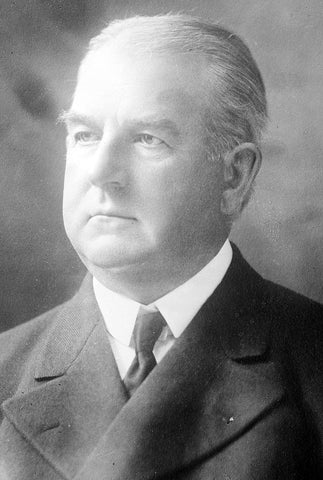
Albert Goodwill Spalding 1849-1915, National Baseball Hall of Fame (1939). A star pitcher in the 1870's, Spalding went on to become baseball's chief chronicler and promoter. He was president of the Chicago White Stockings (today's Chicago Cubs) during their 'round-the-world tour in 1888-89.
Whether in response to the excitement generated by the Spalding tour, or because Britons were predisposed to the adoption of a modern pastime which could be played in three hours rather than over five days, the National Baseball League of Great Britain and Ireland was established in 1890. Baseball has been played in the United Kingdom ever since, with a four-tiered league system run by the British Baseball Federation, as well as various independent leagues, a Great Britain Baseball Academy, university competitions, and representation in the European Baseball Championships and World Baseball Classic. Organized UK baseball capped off a period of pre-World War II popularity with a victory over the United States team in the 1938 Amateur World Series. (Read more about "Baseball in the UK" here).
It may also surprise U.S. fans to know there are fan clubs in the UK for most of the American MLB teams, watching afternoon games on cable at hours when they can be comfortably viewed in the evenings throughout Britain and Ireland. Each team has a social media community (@BravesintheUK; @UKPhillies; @UKRedsMLB; @PadresUK and so forth) as enthusiastic about wins and depressed over losses as hometown fans in the U.S.
Among curators of baseball's storied past, no one can articulate these truths better than MLB's official historian--and philosopher-- John Thorn in his essay "Why Baseball: An American Eden of the Mind:"
While the imperative for Americans has always been to forge ahead, in search of the new, baseball has always been about the past. In this land of opportunity, a man must venture forth to make his own way. Baseball is about coming home...
This great game opens a portal onto our past, both real and imagined, comforting us with intimations of immortality and primordial bliss. But it also holds up a mirror, showing us as we are. And sometimes baseball even serves as a beacon, revealing a path through the wilderness.

"It is true... that baseball is a sort of Rosetta Stone for deciphering our still revolutionary experiment in nationhood," continues Thorn, but as Caseyatthe.blog has suggested, there are themes embedded in baseball even more venerable than those illuminating America's national identity. We in America have been exposed to these verities since 1888 through a poem--a ballad--written by a young man from Worcester, Massachusetts. These dramatic verses, known as "Casey at the Bat," convey to us the mythic elements of ancient drama inherent in the hero's confrontation with fate: hamartia (the "fatal flaw"), hubris (excessive pride or self-confidence), and the ennobling catharsis which is the effect of tragedy on the spectator. As Aristotle observed long ago, "Poetry is more philosophic, and more deserving of attention, than history. For poetry speaks more of universals, but history of particulars." Baseball draws us into the fascination of its particulars; "Casey at the Bat" awakens us to the game's universals.
These are insights with which Ernest Thayer's "Casey at the Bat" has enriched our American game and our American mythology. But just as major league baseball is exerting its universal appeal--in Tokyo, Monterrey, Puerto Rico and London-- so also expands the claim to universality of baseball's most famous ballad.


Oscar Wilde ( 1854-1900 ) and George Bernard Shaw ( 1856 - 1950 ): "Two peoples divided by a common language" is a witticism to which both may claim a share
In 1887 appeared a short story, "The Canterville Ghost" by the renowned aesthete and playwright Oscar Wilde. As the narrator describes one of the characters: "She was quite English, and was an excellent example of the fact that we have really have really everything in common with America nowadays, except, of course, language." Perhaps, according to the online Quote Investigator, this was the genesis of a witticism that by the mid-1940's had become attributed to George Bernard Shaw (or even sometimes to Winston Churchill), and had evolved into its best-known form: "Britain and America are two peoples divided by a common language."

Thomas Babington Macaulay (1800-1859) "I amused myself with trying to restore some of these long perished poems," wrote Macaulay about the Lays of Ancient Rome.
As major league baseball returns to Britain, let's examine the proposition that America and Britain represent two peoples divided by a common ballad. For in fact, the ballad known in America as "Casey at the Bat" can be recognized as a variant -- a misprision or "creative misreading" in Harold Bloom's terms--of the ballad "Horatius." One of four Lays of Ancient Rome penned by British historian and parliamentarian Thomas Macaulay, the ballad published in 1842 became known in America as "Horatius at the Bridge" for its dramatic setting at the Sublician Bridge across the Tiber.
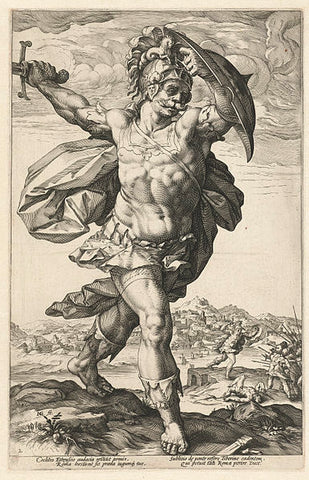 Engraving of Horatius in battle by Hendrik Goltzius, 1586
Engraving of Horatius in battle by Hendrik Goltzius, 1586
It was here, on the western approach to the bridge in 510 BC, that the Roman captain of the guard, Horatius "Cocles" (One-Eye) stood to defy the might of the Etruscan army led by overlord Lars Porsena. Flanked by two sturdy wingmen, Horatius confronted the Etruscans at the narrow bridgehead while his countrymen chopped away at the wooden pilings and abutments behind him. In three vicious rounds of single combat (in Macaulay's version), Horatius and his companions held back the Etruscan vanguard long enough for the Romans to collapse the entire span into the Tiber and to preserve their infant Republic. Macaulay's version of the legend must have seemed, to Ernest Thayer, exquisitely adaptable to the "base ball" ballad he had in mind, for Macaulay adhered to a strict "rule of three" in his account: three Roman defenders confronting three assaults by the Etruscan attackers--who called on nine Etruscan divinities. The third of the Etruscan swordsmen--the esteemed Astur in Macaulay's version -- demonstrated the same confidence and serene forbearance as he confronted Horatius as would be displayed by Thayer's "Casey" approaching his fateful turn at the plate.
"Horatius" was a legend which would resonate far across the centuries to inspire American colonists challenging the might of the British empire in the 18th century, and to embolden Winston Churchill and his countrymen defying the Luftwaffe and Wehrmacht in the 20th.

In 1888, when "Casey" was written, Churchill would win a prize[2] at Harrow for declaiming 1,200 lines of the Lays of Ancient Rome, including the seventy-stanza epic, "Horatius." Churchill would draw on the example of Horatius to inspire the British to defy the threat of Nazi invasion.
Macaulay, in turn, had taken his inspiration from the Roman historian Livy, writing in the Augustan age about the long-ago Roman Republic. Macaulay endeavored to recreate the ancient ballads which the scholars of his day believed had been the source of stories recorded by Livy and other later historians of Rome's earliest days. "I amused myself," wrote Macaulay, "...with trying to restore some of these long perished poems." Macaulay went so far as to place his collection of ballads in historic context, each with an introduction explaining how notional minstrels or balladeers might have regarded the heroic episodes of a distant past.
English critic Matthew Arnold (1822-1888) found in the Lays of Ancient Rome the touchstone of the "grandly bad" in poetry. But this assessment is too harsh: Macaulay's histories, essays, and poetry were adored in America by Henry Wadsworth Longfellow, William Dean Howells, and Louisa May Alcott, among thousands of others. British soldiers in the first World War often recalled the defense of the ancient Roman bridge in describing their own experiences; Churchill relied upon the example of Horatius to inspire his countrymen during the War against Hitler; and generations of British schoolboys kept alive the Lays of Ancient Rome well into the 20th century.

J.R.R. Tolkien as a schoolboy (1892-1973)
The teen-aged J.R. R. Tolkien and his pals at King Edward's School took their rugby seriously--though not too seriously--as evidenced by Tolkien's first attempt at epic poetry, 'The Battle of the Eastern Field' between the "Reds" and the "Greens", written for the school's Chronicle and closely modeled on Macaulay's style in "The Battle of Lake Regillus" one of the Lays of Ancient Rome .

England vs Wales ca 1870
Tolkien, as we know, was a prolific borrower from the legends and languages of the past. Consider Gandalf's defiant stand at the Bridge of Khazad-dum within the ancient dwarf-realm of Moria, as the nine members of the Fellowship of the Ring make their escape from an onslaught of orcs, trolls, and ultimately, the feared demon of the Underworld--the fiery Balrog. As the fleeing Fellowship approach the fearful chasm,
"Over the bridge!" cried Gandalf, recalling his strength. "Fly! This is a foe beyond any of you. I must hold the narrow way." (Italics mine-RCD)

Gandalf and the Bridge of Khazad-dum -- Ted Naismith illustration
The "narrow way" is a figure of speech used repeatedly by Macaulay to refer to the Tiber bridge defended by Horatius Cocles (stanzas XXXVI and XLI ("to win the narrow way") and stanza LII ("scowled at the narrow way"). The term "narrow way" was certainly familiar to Tolkien's generation of schoolboys from their recitations of "Horatius". Like Horatius with Herminius and Lartius, Gandalf defended the "narrow way" flanked by his two companions--valiant defenders Aragorn and Boromir.
But while the legend of Horatius persisted in the living memory of the British public, by the mid-20th-century Macaulay's Lays of Ancient Rome had long since been relegated to the dusty storage shelves of Carnegie Libraries gracing the public squares of towns and cities across America. Why?
I would argue that although the classical legend of "Horatius" continued to resonate in Britain through two world wars, in America the popular retelling of that legend--as "Casey at the Bat"-- had far overshadowed Macaulay's predecessor ballad. Further, in several respects the American version of the legend demonstrated if not superiority, then at least a dramatic distillation of time and place not only affording Americans a unique perspective on their national game--but also affording a favorable contrast to Macaulay's heroic verses.
For one thing, "Casey" with its 52 lines in 13 quatrains was much more concise (and easier to memorize) than Macaulay's 70 stanzas. Macaulay, for example, seems to have tried out three separate endings, and unable to decide among them, concluded by keeping them all! Secondly, listeners sensed that "Casey's" conclusion was somehow more fitting, more believable, and more artful than the daredevil leap by Horatius into the foaming Tiber. Even Livy, in his first-century version of the legend, as translated by T. J. Luce, regarded the Roman captain's escape as "a bit of daring that posterity was to find more praiseworthy than credible."[3]

Aristotle's commentary on the elements of drama remains relevant
Finally, observing Aristotle's conventions of classical drama, which have not been improved upon from ancient times to our own, the ballad of "Casey" brings forth emotions from the audience which Aristotle observed all great tragedy will evoke-- specifically pity and fear. The allure of happy endings notwithstanding, only tragic drama has the ennobling power to draw catharsis from its hearers, just as it did in the days of Sophocles or Aeschylus. And as for humor, Thayer's iconoclastic perception of "the broken edges of things that appear whole"--as recorded by his like-minded classmate George Santayana--found ample opportunity for parody or misprision in Macaulay's far more ambitious endeavor.

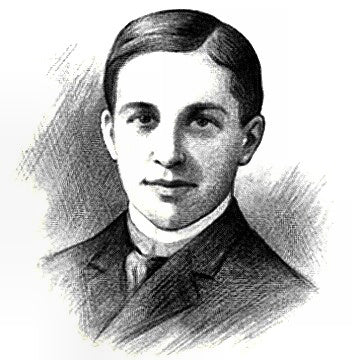
George Santayana (top) and Ernest Thayer as they appeared at Harvard in the 1880's. Writing his memoir in the 1940's, Santayana recalled his friend and fellow Lampoon contributor: "...He seemed a man apart, and his wit was not so much jocular as Mercutio-like, curious and whimsical, as if he saw the broken edges of things that appear whole, and a feeling...that the absurd side of things was pathetic." --George Santayana, Persons and Places (New York: Scribner, 1943), p. 197.
Santayana described Thayer's unique brand of humor as "Mercutio-like" -- referring to Romeo's friend in Shakespeare's play. Mercutio's humor could be witty, punning, coarse, and even sharp-edged. But whether channeling mischief or pathos, Thayer in "Casey at the Bat" would take Macaulay's ballad and turn it on its head. Macaulay's antagonist becomes Thayer's protagonist; Macaulay's Etruscan Empire becomes Thayer's Mudville; Macaulay's heroic saga becomes Thayer’s epic tragedy. So there is an aspect of Casey's ballad that can be only understood as the Greeks would have portrayed it.
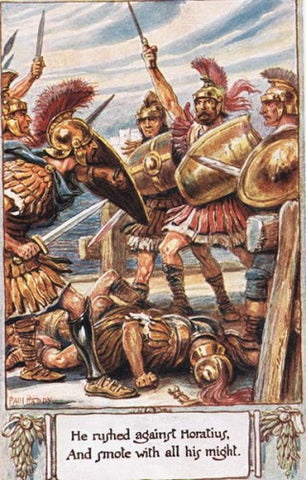
There are many artistic depictions of the Roman captain Horatius from medieval times through the 19th century, but almost none of his principal Etruscan adversary in Thomas Macaulay's version of the legend. English illustrator Paul Hardy (1862-1942) provides a rare image of the assault on Horatius by Astur, Lord of Luna (at right, with upraised sword) -- the gallant Etruscan champion upon whom "Casey" would later be modeled.
Looking forward to the next #LondonSeries, celebrating the flourishing of baseball within that scepter'd isle whose landscape conceals so many reminders of ancient contests, let the English-speaking peoples no longer be divided, but let them be united by a common ballad! And in the meantime Caseyatthe.blog will continue to promote the verse translation of Casey's ballad into all the languages of every nation where baseball is played!

Lars Porsena before the gates of Rome, J.R. Weguelin illustration for Thomas Macaulay's Lays of Ancient Rome
[1] The Standard, London, 18 March 1889.
[2] Randolph S. Churchill, Winston S. Churchill: 1874-1900 (London: Heinemann, 1966), p. 112.
[3] Livy: The Rise of Rome, Books 1-5 [Oxford, Oxford University Press, 1998/2008], p. 81).
[4] Thayer's graduation address at Worcester's Classical and English High School in 1881 was entitled "Roman Polytheism." He carried a solid grounding in Latin, Greek, and the classics with him to Harvard.
Cover illustration: Baseball game on the Crystal Palace grounds, London, March 1889, during the All-Star and Chicago White Stockings globe-circling tour, organized by team president Albert Goodwill Spalding.
#LondonSeries #MLBintheUK @mlblondonseries @mlbuk @baseball_ref @thorn_john @SABR #CaseyattheBat #MLB @britbaseball @GBBaseball @USABaseball
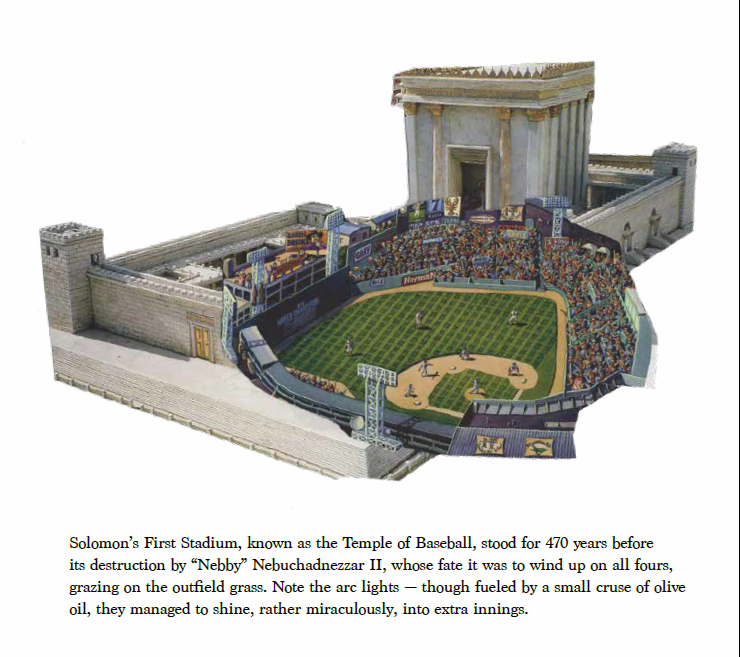

Leave a comment
This site is protected by hCaptcha and the hCaptcha Privacy Policy and Terms of Service apply.